A Spatiotemporal Atmospheric Refraction Correction Method for Improving the Geolocation Accuracy of High-Resolution Remote Sensing Images
Abstract
1. Introduction
2. The Spatiotemporal Atmospheric Refraction Correction Method
2.1. Atmospheric Refraction Error
2.2. The Spatiotemporal Atmospheric Refraction Correction Method
2.2.1. Calculation of the Atmospheric Refractive Index
2.2.2. Spatiotemporal Atmospheric Refraction Model
2.2.3. The Correction of Atmospheric Refraction Error
2.3. Evaluation Index
3. Experiment Results and Discussion
3.1. Experiment Data
3.2. Geopositioning Results of the Proposed SARCM
3.2.1. Geolocation Accuracy after the Spatiotemporal Atmospheric Refraction Correction
3.2.2. Comparison with the State-of-the-Art Atmospheric Refraction Correction Methods
4. Discussion
5. Conclusions
Author Contributions
Funding
Data Availability Statement
Acknowledgments
Conflicts of Interest
Appendix A
- (1)
- The refractive index of dry air under standard atmospheric conditions (temperature of 15 °C, atmospheric pressure of 101,325 Pa, relative humidity of 0%, and CO2 content of 450 ppm) is
- (2)
- At a temperature of 20 °C and a water vapor pressure of 1333 Pa, the refractive index of pure water vapor is
- (3)
- The density of dry air in the current environment is and the density of water vapor is .
- (4)
- Summary of the calculations:
References
- Wang, M.; Cheng, Y.; Chang, X.; Jin, S.; Zhu, Y. On-orbit geometric calibration and geometric quality assessment for the high-resolution geostationary optical satellite GaoFen4. Isprs J. Photogramm. Remote Sens. 2017, 125, 63–77. [Google Scholar] [CrossRef]
- Zhang, G.; Wang, J.; Jiang, Y.; Zhou, P.; Zhao, Y.; Xu, Y. On-Orbit Geometric Calibration and Validation of Luojia 1-01 Night-Light Satellite. Remote Sens. 2019, 11, 264. [Google Scholar] [CrossRef]
- Arafat, N.; Sharawi, A.; Ragab, A. Geographic Accuracy Assessment of Geometric Corrections of World View-3 Satellite Images Using Polynomial Model (Dept. C). MEJ. Mansoura Eng. J. 2020, 45, 7–13. [Google Scholar] [CrossRef]
- Li, X.; Yang, L.; Su, X.; Hu, Z.; Chen, F. A Correction Method for Thermal Deformation Positioning Error of Geostationary Optical Payloads. IEEE Trans. Geosci. Remote Sens. 2019, 57, 7986–7994. [Google Scholar] [CrossRef]
- Wang, M.; Cheng, Y.; Tian, Y.; He, L.; Wang, Y. A New On-Orbit Geometric Self-Calibration Approach for the High-Resolution Geostationary Optical Satellite GaoFen4. IEEE J. Sel. Top. Appl. Earth Obs. Remote Sens. 2018, 11, 1670–1683. [Google Scholar] [CrossRef]
- Wang, M.; Cheng, Y.; Guo, B.; Jin, S. Parameters determination and sensor correction method based on virtual CMOS with distortion for the GaoFen6 WFV camera. ISPRS J. Photogramm. Remote Sens. 2019, 156, 51–62. [Google Scholar] [CrossRef]
- Storey, J.; Choate, M.; Lee, K. Landsat 8 Operational Land Imager On-Orbit Geometric Calibration and Performance. Remote Sens. 2014, 6, 11127–11152. [Google Scholar] [CrossRef]
- Hp, A.; Tao, H.A.; Ping, Z.B.; Zc, A. Self-calibration dense bundle adjustment of multi-view Worldview-3 basic images. ISPRS J. Photogramm. Remote Sens. 2021, 176, 127–138. [Google Scholar]
- Ye, J.; He, H.; Zhang, L.; Lin, X.; Qiang, Y. An Accurate Calculation of the Atmospheric Refraction Error of Optical Remote Sensing Images Based on the Fine-Layered Light Vector Method. IEEE J. Sel. Top. Appl. Earth Obs. Remote Sens. 2022, 15, 1514–1525. [Google Scholar] [CrossRef]
- Noerdlinger, P.D. Atmospheric refraction effects in Earth remote sensing. Isprs J. Photogramm. Remote Sens. 1999, 54, 360–373. [Google Scholar] [CrossRef]
- Schubert, A.; Jehle, M.; Small, D.; Meier, E. Influence of Atmospheric Path Delay on the Absolute Geolocation Accuracy of TerraSAR-X High-Resolution Products. IEEE Trans. Geosci. Remote Sens. 2010, 48, 751–758. [Google Scholar] [CrossRef]
- Wang, Y.; Zhu, Y.; Wang, M.; Jin, S.; Rao, Q. Atmospheric Refraction Calibration of Geometric Positioning for Optical Remote Sensing Satellite. IEEE Geosci. Remote Sens. Lett. 2020, 99, 1–5. [Google Scholar] [CrossRef]
- Wang, M.; Zhu, Y.; Wang, Y.; Cheng, Y. The Geometric Imaging Model for High-Resolution Optical Remote Sensing Satellites Considering Light Aberration and Atmospheric Refraction Errors. Photogramm. Eng. Remote Sens. 2020, 86, 373–382. [Google Scholar] [CrossRef]
- Edlén, B. The refractive index of air. Metrologia 1966, 2, 71. [Google Scholar] [CrossRef]
- Roper, L.D. Precipitation Rate versus Latitude and Longitude. 2011. Available online: http://www.roperld.com/science (accessed on 20 September 2022).
- Portland State Aerospace Society. A Quick Derivation Relating Altitude to Air pressure; Portland State Aerospace Society: Portland, OR, USA, 2004; Available online: http://psas.pdx.edu/RocketScience/PressureAltitude_Derived.pdf (accessed on 20 September 2022).
- Agbo, E.P.; Ekpo, C.M.; Edet, C.O. Trend Analysis of Meteorological Parameters, Tropospheric Refractivity, Equivalent Potential Temperature for a Pseudoadiabatic Process and Field Strength Variability, Using Mann Kendall Trend Test and Sens Estimate. arXiv 2020, arXiv:2010.04575. [Google Scholar]
- Ogunjo, S.T.; Adesiji, N.E. Statistics of vertical refractivity gradient over Akure, Nigeria. In 2020 XXXIIIrd General Assembly and Scientific Symposium of the International Union of Radio Science; IEEE: Manhattan, NY, USA, 2020; p. 4. [Google Scholar]
- Smith, E.K.; Weintraub, S. The Constants in the Equation for Atmospheric Refractive Index at Radio Frequencies. Proc. IRE 1953, 41, 1035–1037. [Google Scholar] [CrossRef]
- Yan, M.; Wang, C.; Ma, J.; Wang, Z.; Yu, B. Correction of Atmospheric Refraction Geolocation Error for High Resolution Optical Satellite Pushbroom Images. Photogramm. Eng. Remote Sens. 2016, 82, 427–435. [Google Scholar] [CrossRef]
- Ciddor, P.E. Refractive index of air: New equations for the visible and near infrared. Appl. Opt. 1996, 35, 1566–1573. [Google Scholar] [CrossRef]
- Saha, S.; Moorthi, S.; Pan, H.-L.; Wu, X.; Wang, J.; Nadiga, S.; Tripp, P.; Kistler, R.; Woollen, J.; Behringer, D.; et al. NCEP Climate Forecast System Reanalysis (CFSR) 6-hourly Products, January 1979 to December 2010. In Research Data Archive at the National Center for Atmospheric Research, Computational and Information Systems Laboratory; RDA: Boulder, CO, USA, 2010. [Google Scholar]
- Barrell, H.; Sears, J.J.E. The refraction and dispersion of air and dispersion of air for the visible spectrum. Philos. Trans. R. Soc. Lond. 1939, 238, 1–64. [Google Scholar]
- Friehe, C.A.; La Rue, J.C.; Champagne, F.H.; Gibson, C.H.; Dreyer, G.F. Effects of temperature and humidity fluctuations on the optical refractive index in the marine boundary layer. J. Opt. Soc. Am. 1975, 65, 1502–1511. [Google Scholar] [CrossRef]
- Jin, Q. Study of Factors Influencing Atmospheric Refractive Index. Master’s Thesis, Zhejiang University, Hangzhou, China, 2006. [Google Scholar]
- Edlén, B. The Dispersion of Standard Air*. J. Opt. Soc. Am. 1953, 43, 339–344. [Google Scholar] [CrossRef]
- Owens, J.C. Optical Refractive Index of Air—Dependence On Pressure Temperature and Composition. Appl. Opt. 1967, 6, 51. [Google Scholar] [CrossRef] [PubMed]
- Ciddor, P.E.; Hill, R.J. Refractive index of air. 2. Group index. Appl. Opt. 1999, 38, 1663–1667. [Google Scholar] [CrossRef] [PubMed]
- Peck, E.R.; Reeder, K. Dispersion of Air*. J. Opt. Soc. Am. 1972, 62, 958–962. [Google Scholar] [CrossRef]
- Goncalves, H.; Goncalves, J.A.; Corte-Real, L. Measures for an Objective Evaluation of the Geometric Correction Process Quality. IEEE Geosci. Remote Sens. Lett. 2009, 6, 292–296. [Google Scholar] [CrossRef]
- Li, J.; Hu, Q.; Ai, M. RIFT: Multi-Modal Image Matching Based on Radiation-Variation Insensitive Feature Transform. IEEE Trans. Image Process. 2020, 29, 3296–3310. [Google Scholar] [CrossRef]
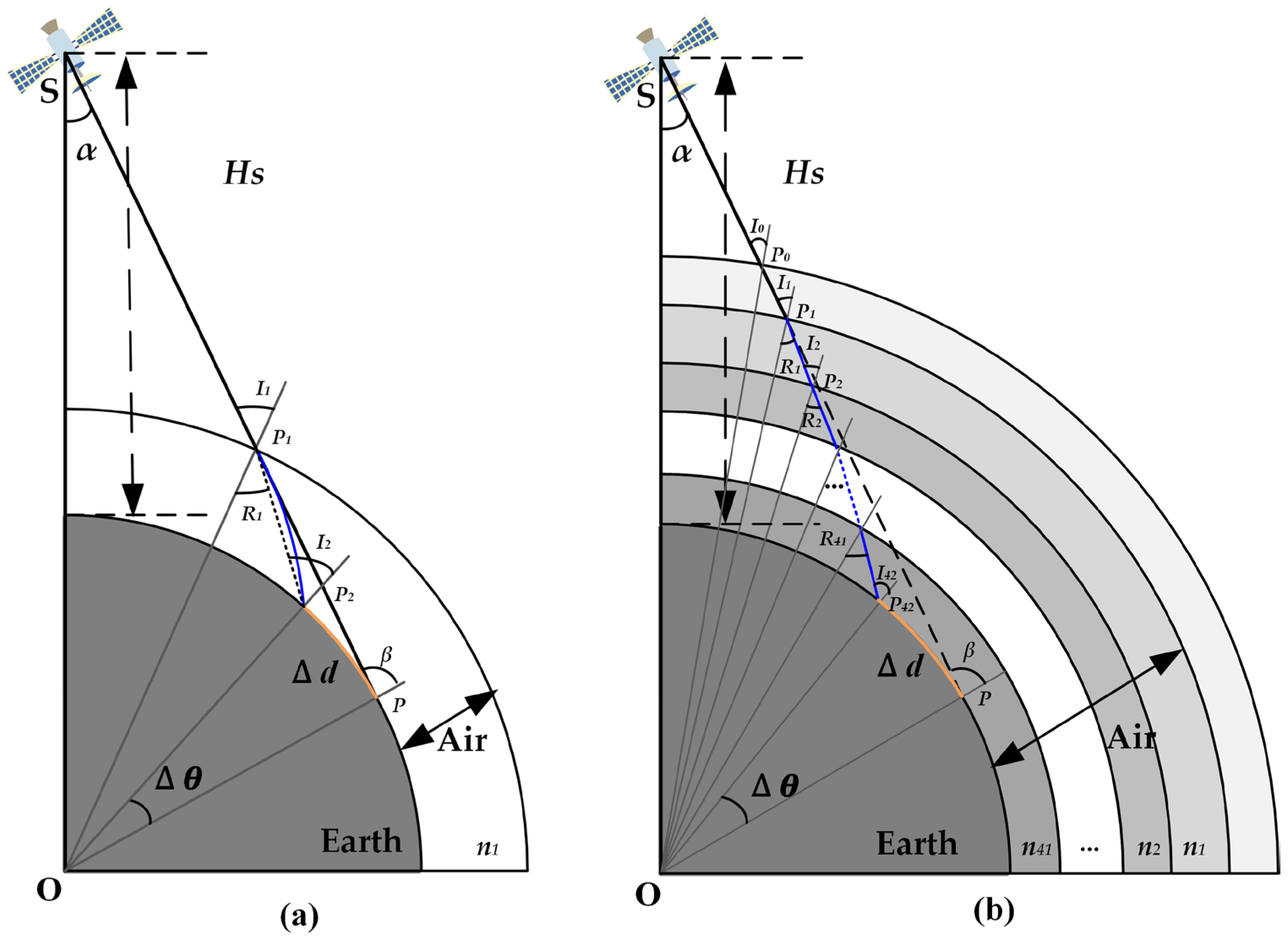
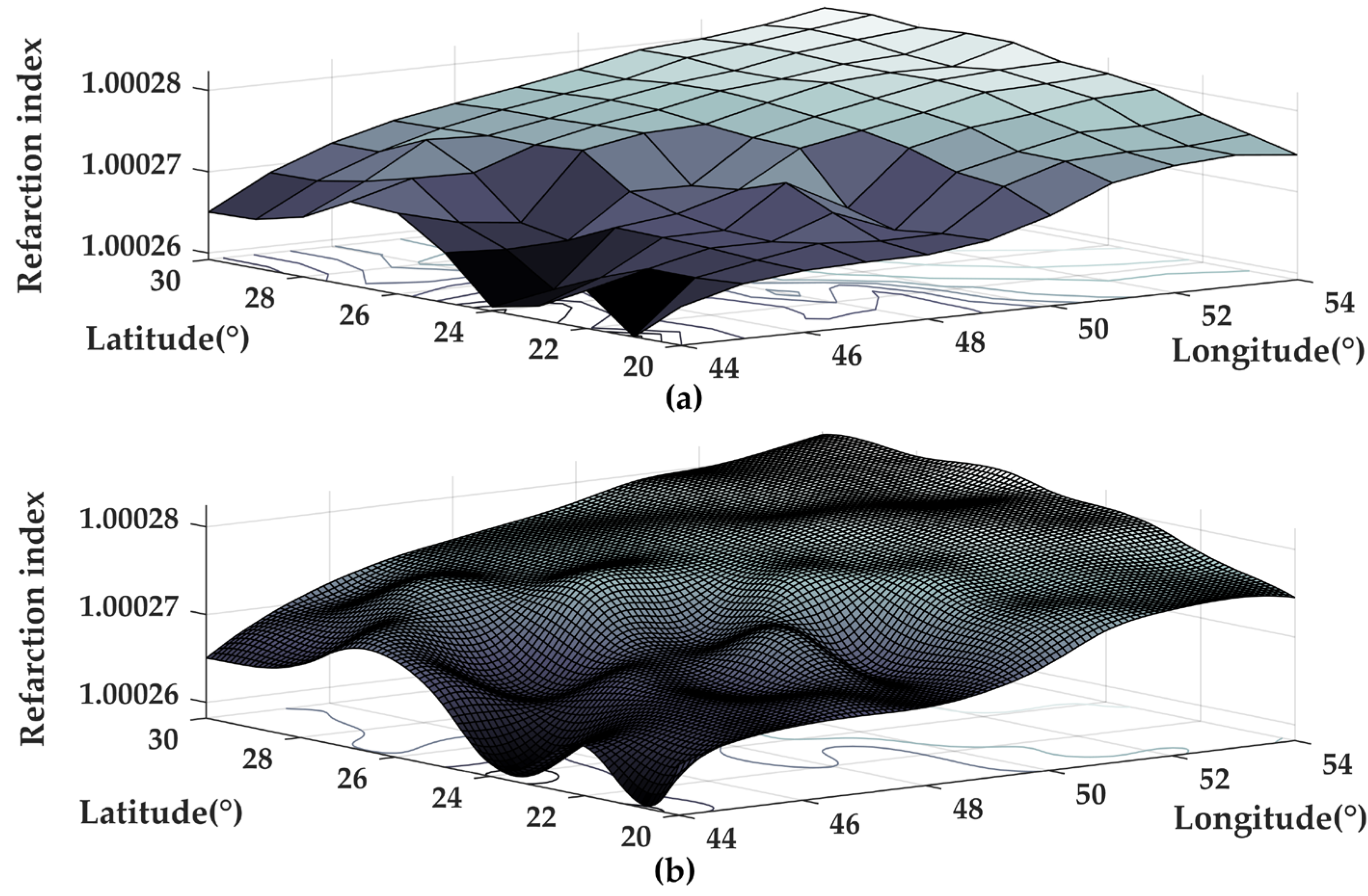
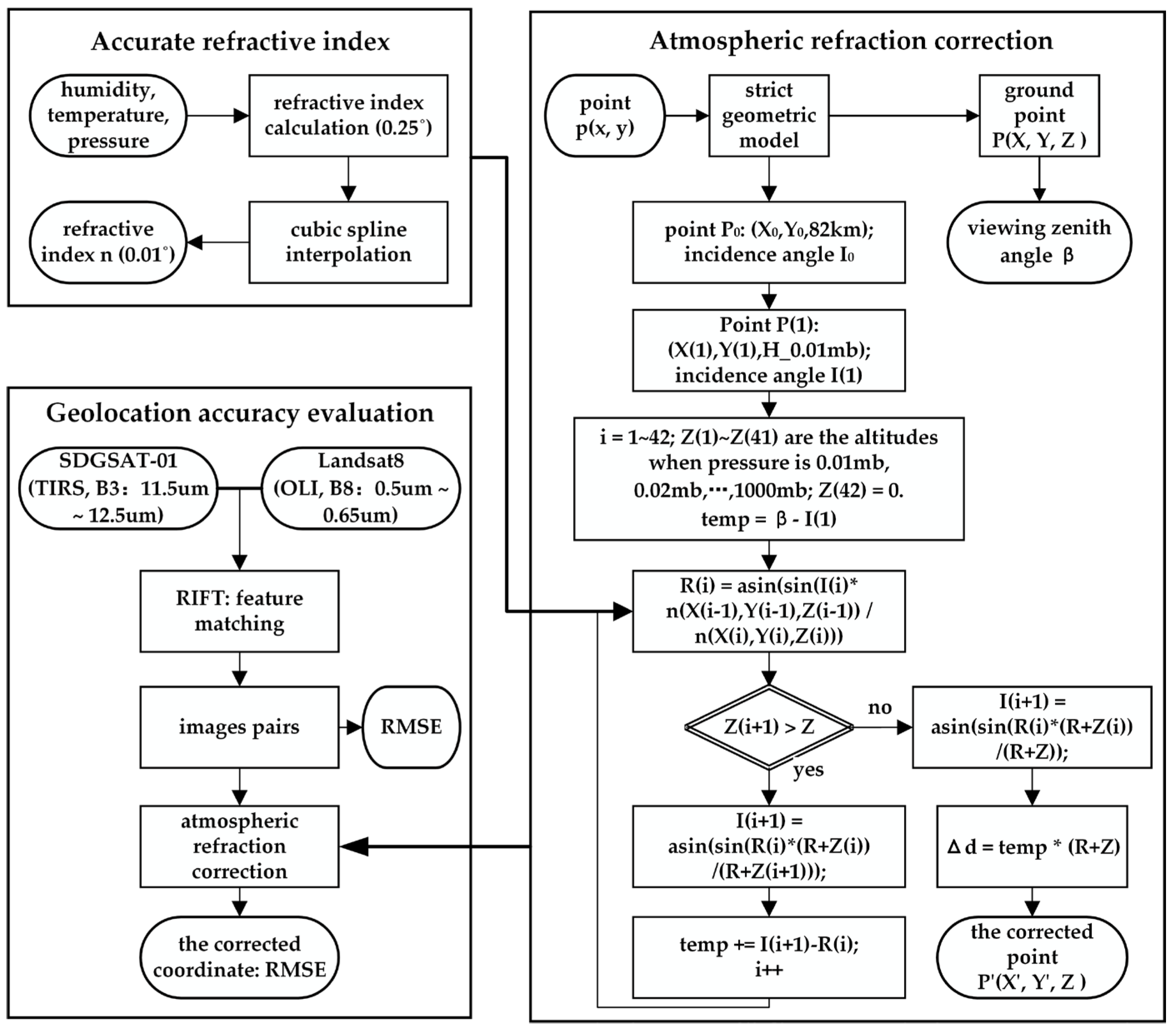
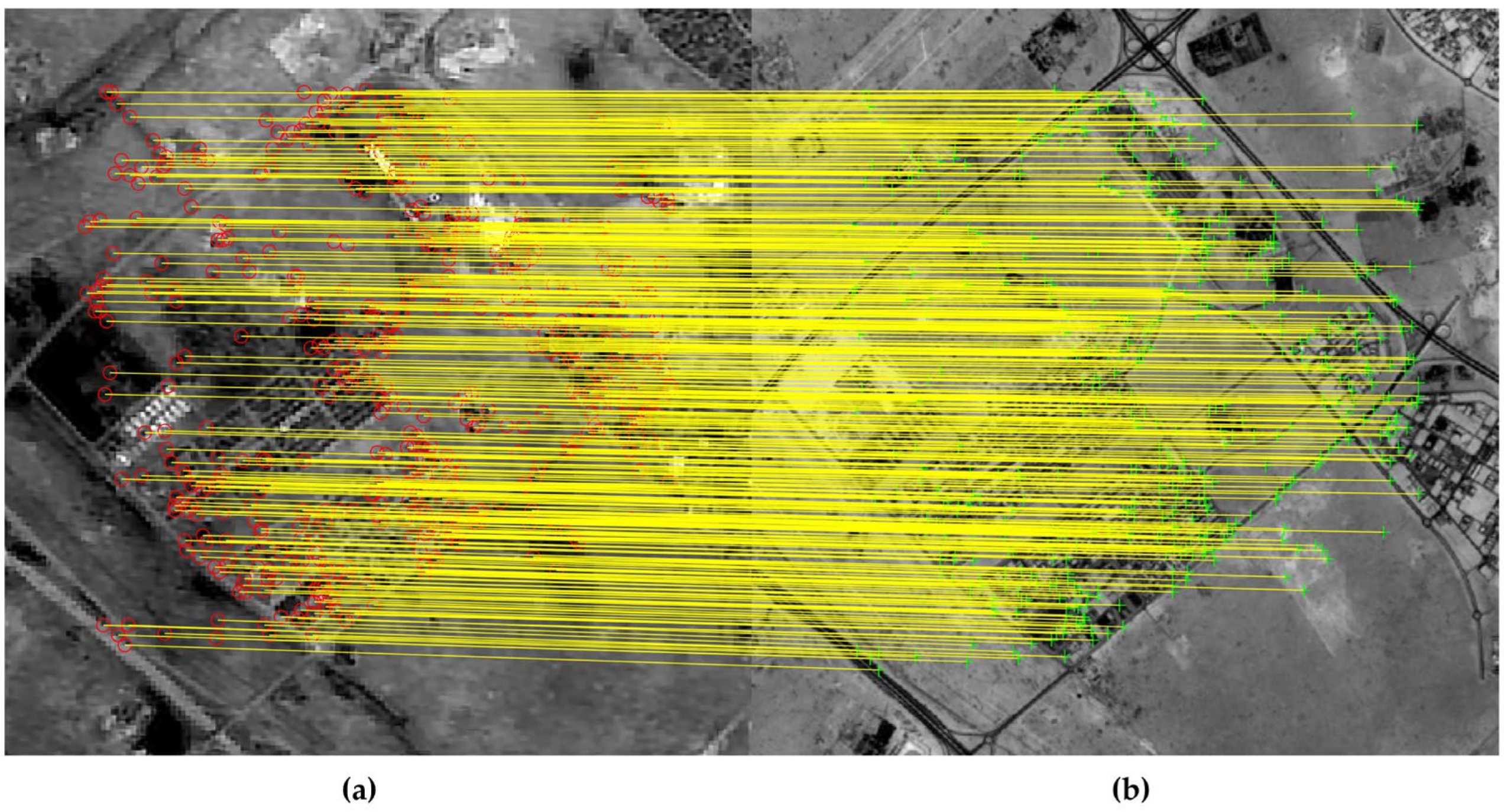
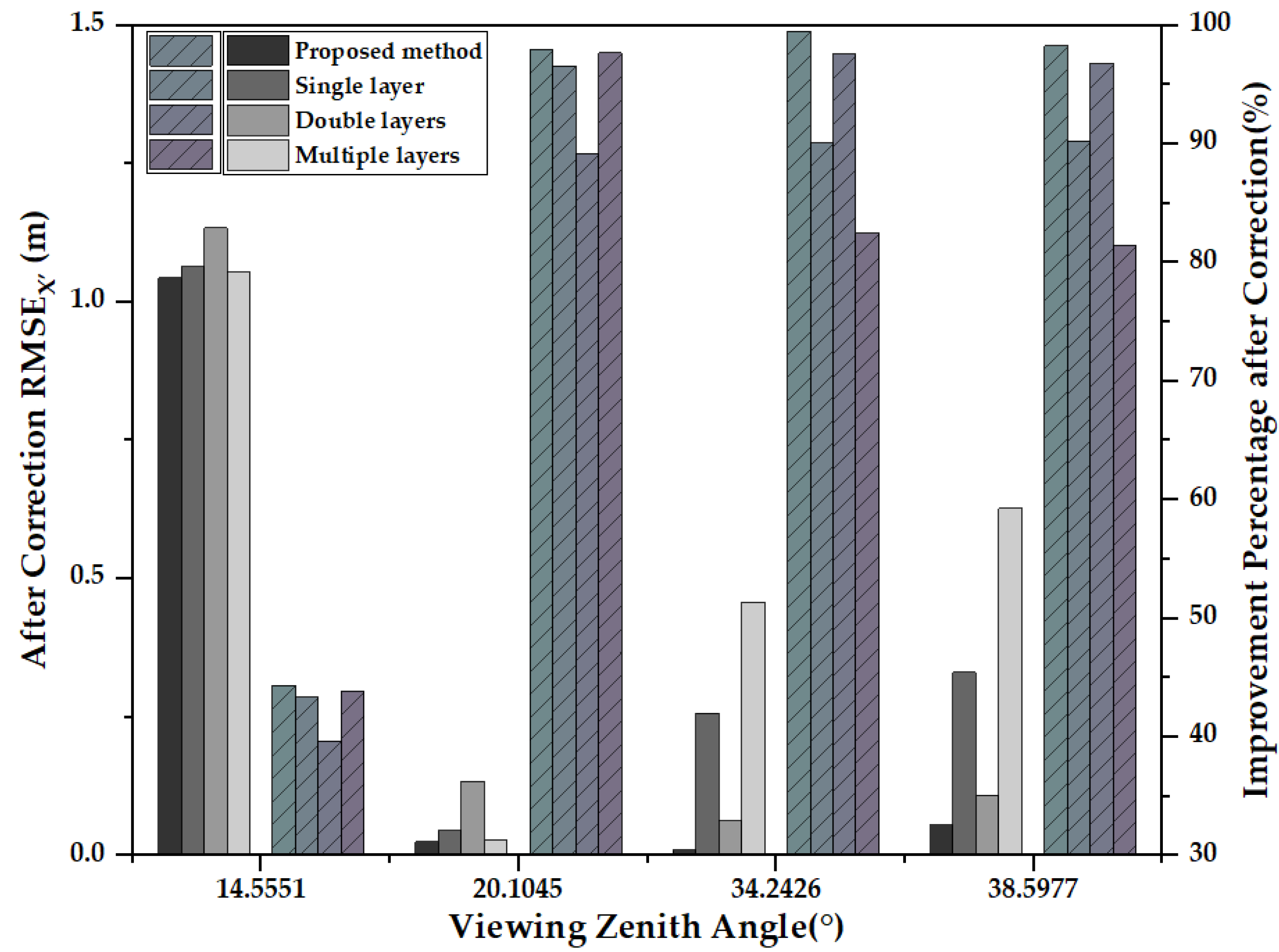

| Technical Indicators | SDGSAT-01 (TIS) | Landsat8 (OLI) |
|---|---|---|
| Band () | B3: 11.5–12.5 | B8: 0.5–0.65 |
| GSD (m) | 30 @ 505 km | 15 @ 705 km |
| Swath (km) | 300 @ 505 km | 185 @ 705 km |
| Side swing angle () | / | |
| Geometric accuracy (m) | / | RMSE: 8.695 |
| Image ID | 01 | 02 | 03 | 04 | 05 | 06 |
|---|---|---|---|---|---|---|
| SDGSAT-01 (TIS: 11.5~12 ) | 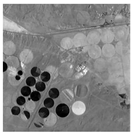 |  | 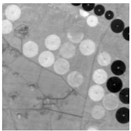 | 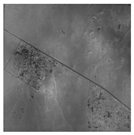 |  | 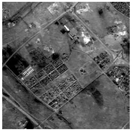 |
| Landsat8 (OLI: 0.5~0.65 ) | 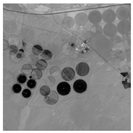 | 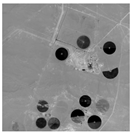 | 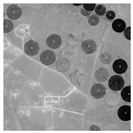 | 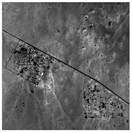 | 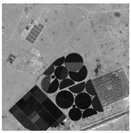 | 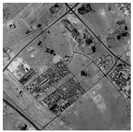 |
| Center viewing zenith angle | 7.5570 | 14.5551 | 20.1045 | 29.3865 | 34.2426 | 38.5977 |
| Center geolocation | (48.0367°E, 24.1735°N) | (48.7190°E, 23.9865°N) | (49.2136°E, 23.9290°N) | (50.3833°E, 24.9309°N) | (50.9981°E, 25.2468°N) | (51.4967°E, 25.1005°N) |
| Image ID | Center Viewing Zenith Angle () | Atmospheric Refraction Error (m) | Difference between Bands (m) | |
|---|---|---|---|---|
| 03 | 20.1486 | B1: 11.5~12.5 | 1.2000 | B1, B2: 0.0003 |
| B2: 3.75~4.75 | 1.2003 | B2, B3: 0.0191 | ||
| B3: 0.50~0.65 | 1.2194 | B1, B3: 0.0194 | ||
| 05 | 34.2248 | B1: 11.5~12.5 | 2.5215 | B1, B2: 0.0007 |
| B2: 3.75~4.75 | 2.5222 | B2, B3: 0.0455 | ||
| B3: 0.50~0.65 | 2.5677 | B1, B3: 0.0462 | ||
| 06 | 38.4458 | B1: 11.5~12.5 | 3.3193 | B1, B2: 0.0009 |
| B2: 3.75~4.75 | 3.3202 | B2, B3: 0.0592 | ||
| B3: 0.50~0.65 | 3.3794 | B1, B3: 0.0601 |
| Image ID | Center Viewing Zenith Angle () | Before Correction | After Correction | Improvement | |||
|---|---|---|---|---|---|---|---|
| RMSEX (m) | RMSEY (m) | RMSEX′ (m) | RMSEY′ (m) | X | Y | ||
| 01 | 7.5570 | 4.8678 | −4.6322 | 4.4468 | −4.5580 | 8.6% | 1.6% |
| 02 | 14.5551 | 1.8802 | −9.6321 | 1.0446 | −9.4848 | 44.4% | 1.5% |
| 03 | 20.1045 | 1.2510 | −5.9958 | 0.0256 | −5.7798 | 98.0% | 3.6% |
| 04 | 29.3865 | 5.3498 | −6.0296 | 3.1191 | −5.6363 | 41.7% | 6.5% |
| 05 | 34.2426 | 2.6150 | −27.9704 | 0.0100 | −27.5111 | 99.5% | 1.6% |
| 06 | 38.5977 | 3.4009 | −31.9704 | 0.0565 | −31.3807 | 98.3% | 1.8% |
| Center Viewing Zenith Angle () | Correction Method | Before Correction | After Correction | Improvement | |||
|---|---|---|---|---|---|---|---|
| RMSEX (m) | RMSEY (m) | RMSEX′ (m) | RMSEY′ (m) | X | Y | ||
| 14.5551 | Proposed method | 1.8802 | 9.6321 | 1.0446 | −9.4848 | 44.4% | 1.5% |
| Single-layer | 1.0645 | −9.4883 | 43.4% | 1.5% | |||
| Double layers | 1.1344 | −9.5006 | 39.7% | 1.4% | |||
| Multiple layers | 1.0547 | −9.4865 | 43.9% | 1.5% | |||
| 20.1045 | Proposed method | 1.2510 | 5.9958 | 0.0256 | −5.7797 | 98.0% | 3.6% |
| Single-layer | 0.0424 | −5.7827 | 96.6% | 3.6% | |||
| Double layers | 0.1345 | −5.7990 | 89.2% | 3.3% | |||
| Multiple layers | 0.0292 | −5.7701 | 97.7% | 3.8% | |||
| 34.2426 | Proposed method | 2.6150 | 27.9704 | 0.0100 | −27.5111 | 99.5% | 1.6% |
| Single-layer | 0.2579 | −27.4639 | 90.1% | 1.8% | |||
| Double layers | 0.0636 | −27.4981 | 97.6% | 1.7% | |||
| Multiple layers | 0.4585 | −27.4285 | 82.5% | 1.9% | |||
| 38.5977 | Proposed method | 3.4009 | 31.9704 | 0.0565 | −31.3807 | 98.3% | 1.8% |
| Single-layer | 0.3312 | −31.3124 | 90.3% | 2.1% | |||
| Double layers | 0.1093 | −31.3515 | 96.8% | 1.9% | |||
| Multiple layers | 0.6279 | −31.2600 | 81.5% | 2.2% | |||
Publisher’s Note: MDPI stays neutral with regard to jurisdictional claims in published maps and institutional affiliations. |
© 2022 by the authors. Licensee MDPI, Basel, Switzerland. This article is an open access article distributed under the terms and conditions of the Creative Commons Attribution (CC BY) license (https://creativecommons.org/licenses/by/4.0/).
Share and Cite
Peng, X.; Huang, W.; Li, X.; Yang, L.; Chen, F. A Spatiotemporal Atmospheric Refraction Correction Method for Improving the Geolocation Accuracy of High-Resolution Remote Sensing Images. Remote Sens. 2022, 14, 5344. https://doi.org/10.3390/rs14215344
Peng X, Huang W, Li X, Yang L, Chen F. A Spatiotemporal Atmospheric Refraction Correction Method for Improving the Geolocation Accuracy of High-Resolution Remote Sensing Images. Remote Sensing. 2022; 14(21):5344. https://doi.org/10.3390/rs14215344
Chicago/Turabian StylePeng, Xiaohong, Wenwen Huang, Xiaoyan Li, Lin Yang, and Fansheng Chen. 2022. "A Spatiotemporal Atmospheric Refraction Correction Method for Improving the Geolocation Accuracy of High-Resolution Remote Sensing Images" Remote Sensing 14, no. 21: 5344. https://doi.org/10.3390/rs14215344
APA StylePeng, X., Huang, W., Li, X., Yang, L., & Chen, F. (2022). A Spatiotemporal Atmospheric Refraction Correction Method for Improving the Geolocation Accuracy of High-Resolution Remote Sensing Images. Remote Sensing, 14(21), 5344. https://doi.org/10.3390/rs14215344







